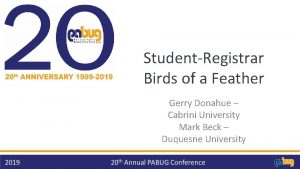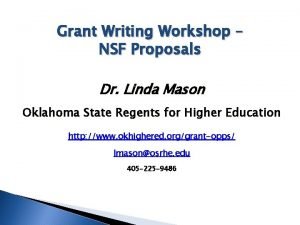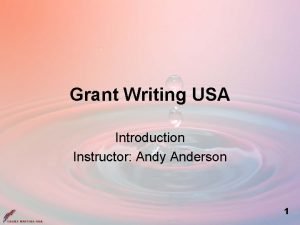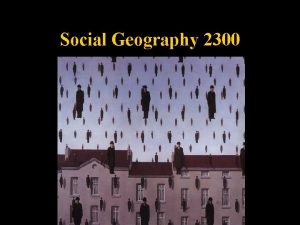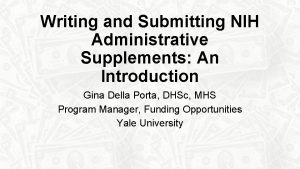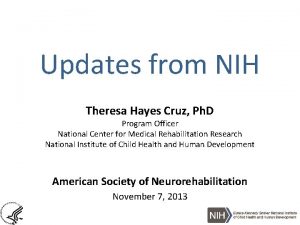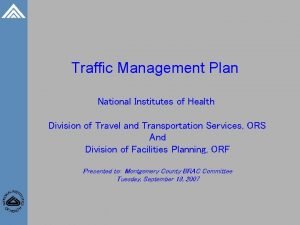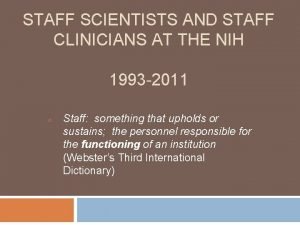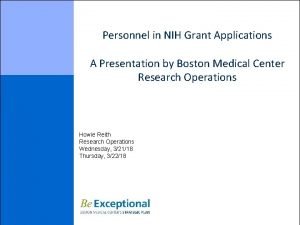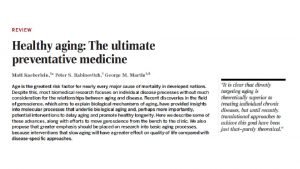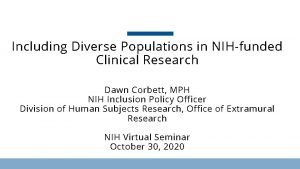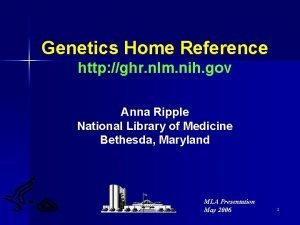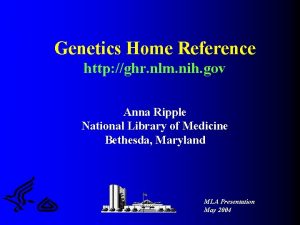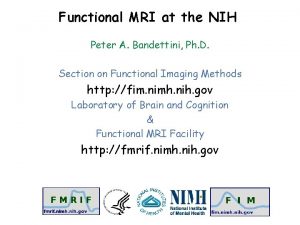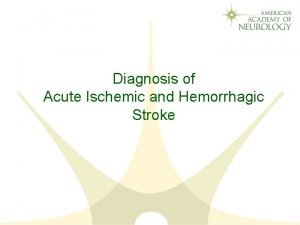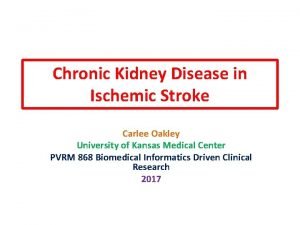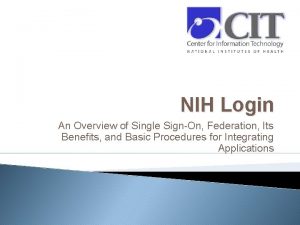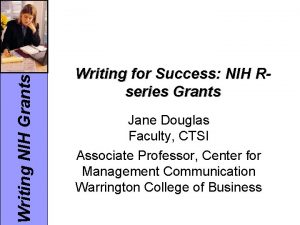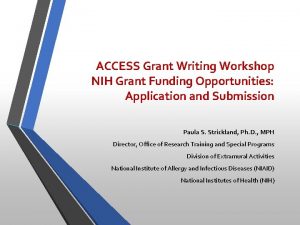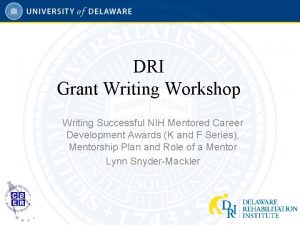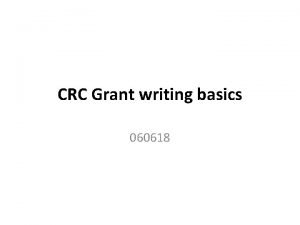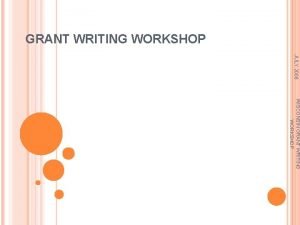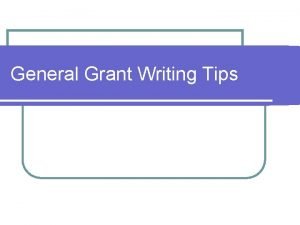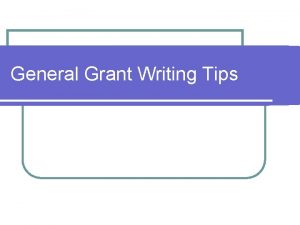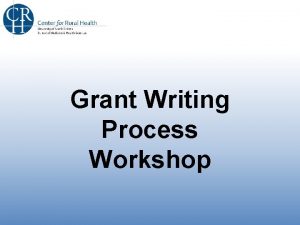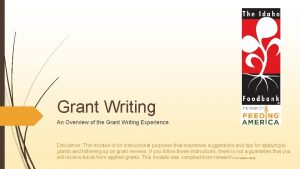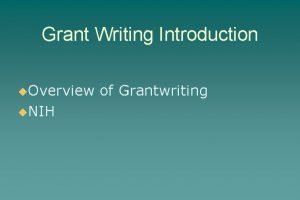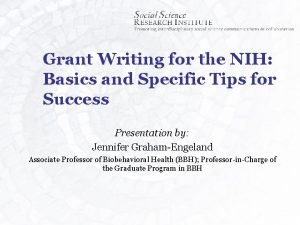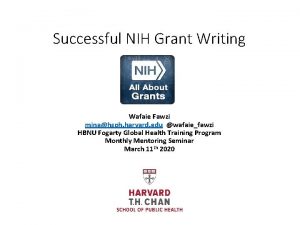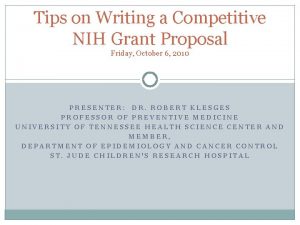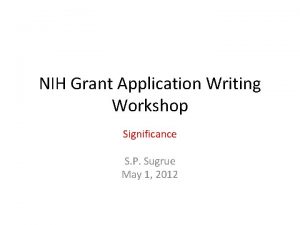NIH Grant Writing Richard P Donahue University of































- Slides: 31

NIH Grant Writing Richard P. Donahue, University of Buffalo

Assignment to an IRG Ø Cover letter requesting a specific study section. Ø Put keywords in title and abstract.

R 01 Review Criteria Ø Is it novel? Ø Investigators Ø Is it significant? Ø Environment Ø Approach * Outcome Measure * Exposure or main effect * Covariates * Analysis * Power Ø Minority/Gender Ø Human Subjects

General Types of Grants Ø Clinical Ø Etiology Ø Prevention

R 01 Review Criteria Significance Does this study address an important problem? If the aims of the application are achieved, how will scientific knowledge be advanced? What will be the effect of these studies on the concepts or methods that drive this field?

R 01 Review Criteria Approach Are the conceptual framework, design (including composition of study population), methods, and analyses adequately developed, well-integrated, and appropriate to the aims of the project? Does the applicant acknowledge potential problem areas and consider alternative tactics?

R 01 Review Criteria Innovation Does the project employ novel concepts, approaches or methods? Are the aims original and innovative? Does the project challenge existing paradigms or develop new methodologies or technologies?

R 01 Review Criteria Investigator Is the investigator appropriately trained and well suited to carry out this work? Is the work proposed appropriate to the experience level of the principal investigator and other researchers (if any)? PLEASE DO NOT INCLUDE descriptive biographical information unless important to the evaluation of merit.

R 01 Review Criteria Environment Does the scientific environment in which the work will be done contribute to the probability of success? Do the proposed experiments take advantage of unique features of the scientific environment or employ useful collaborative arrangements? Is there evidence of institutional support? PLEASE DO NOT INCLUDE description of available facilities or equipment unless important to the evaluation of merit.

R 01 Review Criteria Overall Evaluation In one paragraph, briefly summarize the most important points of the Critique, addressing the strengths and weaknesses of the application in terms of the five review criteria. Recommended a score reflecting the overall impact of the project on the field, weighting the review criteria, as you feel appropriate for each application. An application does not need to be strong in all categories to be judged likely to have a major scientific impact and, thus, deserve a high merit rating. For example, an investigator may propose to carry out important work that by its nature is not innovative, but is essential to move a field forward.

Notes Concerning Funding Ø Study Sections are advisory in nature - do not make funding decisions. Ø Funding is decided at the Institute level with Advisory Council approval. Ø Institutions do not have to fund in order of priority score. Ø “Portfolio Balance” - may go outside the priority score order to fund grants that address needed areas. Ø Study Sections - “Unscore” one-half of all R 01 submissions - approximately a score of 2. 8 or above. Ø Fellowship applications cannot be unscored (scored 1 to 5)

Types of Grants (1) Ø R 03 - Analysis only. Limited in $ (50 K) total Limited in years (2 years) Ø R 21 - Support to investigators changing areas of research. Limited in $ (100 K) total Limited in years (2 or 3 years) Ø R 01 - Most investigator-initiated proposals. Average cost =300 k/year (total) Years of support limited to 4 years (NHLBI)

Types of Grants (2) Ø R 29 - FIRST AWARD No longer accepted Ø NRSA - Institutional Individual Ø K Series - Clinician Scientist

Reviewer’s Comments The following is a list (in no particular order) of aspects of grant applications on which reviewers make comments or with which they express concerns.

Reviewer’s Comments (cont’d) Ø Representativeness of study samples Ø Generalizability Ø duration of the study/timing/sequencing Ø Absence of timelines/organization charts/graphic depictions of study designs Ø Conceptual/empirical rationales for variable

Reviewer’s Comments (cont’d) Ø Statistical analyses/power analyses Ø Protection of human subjects consideration of physicians as subjects availability of draft or final informed consent form specification of risks for each treatment inclusion/exclusion criteria Ø Staffing (commensurate with scope of work; appropriate expertise at correct times); absence of justification

Reviewer’s Comments (cont’d) Ø Budget (contributed time; flat over life of project) Ø Developmental or demonstration projects (need evaluation component Ø Hypothesis-generating vs. hypothesis-testing designs Ø Quantification of assertions/unfounded assertions Ø Instruments (pre-testing, reliability, validity, psychometerics evaluations); draft of finals included in appendices?

Reviewer’s Comments (cont’d) Ø Roles of staff (organization chart often helpful) Ø Letters of support/commitment (need assurances of commitment/collaboration), “in kind” support Ø Outcomes measures clearly specified? Ø Representativeness of study sample (gender and ethnicity); statistical data presented? (absence of this information necessitates entering a code that will preclude timely funding) Ø Matching objectives/hypotheses/process

Reviewer’s Comments (cont’d) Ø Subject attrition, response rate, recruitment, incentives Ø Confounding/contamination considerations Ø Inclusion of relevant publications (appendix) Ø Comparison studies vs. descriptive studies (the former do better in review Ø Availability of preliminary data Ø Use of medical charts for accessing data (missing data, variability); factoring in time and effort required.

Reviewer’s Comments (cont’d) Ø Homogeneity in cultures and race; acculturation Ø Self-report/social desirability/recall bias/selfidentification/self-selection Ø Limitations of study and how they will be handled Ø Clarification of use of various scales (why they are used/not used)

Reviewer’s Comments (cont’d) Ø Addressing research issues from multicultural/multidisciplinary perspective Ø Proposing too many activities within one application Ø Internal/external validity Ø Allocation on the timeline for data analysis and report writing Ø clear statement of hypotheses, focused appropriately

Reviewer’s Comments (cont’d) Ø Educational/reading levels of subects who must read instruments or participate in an intervention Ø Inappropriate, excessive use of jargon in the application Ø Matching study design to the questions posed Ø Clarifying the unit of analysis Ø Budget - make sure totals are correct in all columns Ø Absence of an appropriate comparison

Reviewer’s Comments (cont’d) Ø Adequate amount of data for characterizing research subjects Ø evidence of experience in management of large, multisite projects Ø time commitments of investigators (Other Support) Ø maintaining confidentiality of data (storage/handling) Ø tieing literature to hypothesis

Reviewer’s Comments (cont’d) Ø Translation/back translation (demonstrate understanding of the complexities of this effort for surveys Ø Use of advisory committees, executive committees to oversee large, complex, multisite, multi-investigator projects Ø Acknowledge temporal events, background noise

Reviewer’s Comments (cont’d) Ø Define endpoints clearly Ø use standard, appropriate English, have a disinterested colleague review for clarity and grammar; spell-check document

Agenda Ø Ø Getting started Sources of funding Different types of grants: Examples Elements in the receipt and review process Ø Elements in Writing a good application Ø Overview of budget process Ø Building a Multidisciplinary Team Ø Use of consultants - Letters of Support Ø Wrap up

Overview of Agenda Ø Grant Opportunities in Research Training, and Career Development Ø The Grant Application Process Ø Focusing and Packaging a Good Funding Idea Ø Receipt and Referral Process Ø Review Process

How a Research Grant is Made Investigator initiates research ideas School or other Research Center ? ? ? Submits Application Allocates Funds National Institutes of Health NIH Division of Research Grants assigns Study Section & Institute Study Section evaluates for scientific merit Institute evaluates for Program Relevance Advisory Council recommends action Conducts research Institute Director takes final action for NIH director

Dual Review System for Grant Applications First Level of Review Scientific Review Group • Provide initial scientific review of grant applications • Recommend appropriate level of support and duration of award Second Level of Review Council • Assess quality of SRG review of grant application • Make recommendations to institute staff on funding • Evaluate program priorities and relevance • Advise on policy

Sample Application Number Individual Research Grant 1 R 01 New Application Serial Number Amended NR 12345 01 A 1 National Institute of Nursing Research Grant Support Year

Streamlined Summary Statements Ø Critiques are unedited comments of individual reviewers prepared prior to the discussion. Ø Critiques do NOT reflect committee deliberations and conclusions.
 Dr patrice donahue
Dr patrice donahue Derek donahue
Derek donahue Dr carly donahue
Dr carly donahue Gina donahue
Gina donahue Gerry donahue
Gerry donahue Marashlian & donahue pllc
Marashlian & donahue pllc Trearty
Trearty Looking for richard analysis
Looking for richard analysis Grant writing examples
Grant writing examples Grant writing tutorial
Grant writing tutorial Grant writing usa
Grant writing usa Richard anderson york university
Richard anderson york university Richard davidson andrews university
Richard davidson andrews university Administrative supplement nih
Administrative supplement nih Theresa cruz nih
Theresa cruz nih Transhare nih
Transhare nih Staff scientist nih
Staff scientist nih Nih all personnel report
Nih all personnel report Jonathan pollock nih
Jonathan pollock nih Building 37 nih
Building 37 nih Nih institutes and centers
Nih institutes and centers Dawn corbett nih
Dawn corbett nih Ghr.nlm.nih
Ghr.nlm.nih Http://ghr.nlm.nih.gov/
Http://ghr.nlm.nih.gov/ Chris baker nih
Chris baker nih Alison lin nih
Alison lin nih Differential diagnosis of stroke
Differential diagnosis of stroke Nih stroke scale
Nih stroke scale Portfolio introduction
Portfolio introduction Cit nih
Cit nih Nih.gov
Nih.gov Nih background
Nih background




